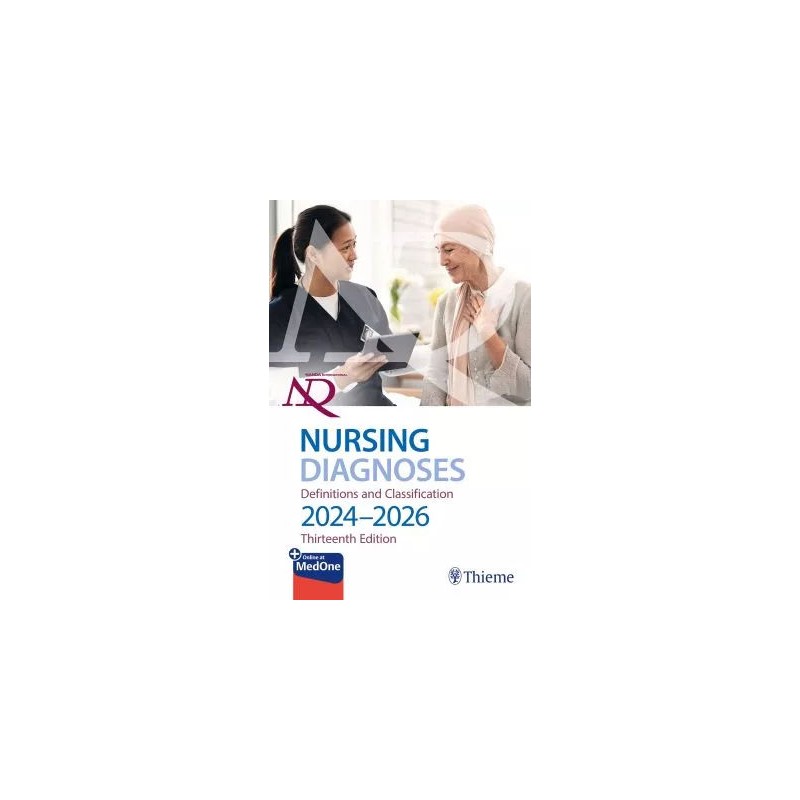- Reduced price

Order to parcel locker

easy pay


 Delivery policy
Delivery policy
Choose Paczkomat Inpost, Orlen Paczka, DHL, DPD or Poczta Polska. Click for more details
 Security policy
Security policy
Pay with a quick bank transfer, payment card or cash on delivery. Click for more details
 Return policy
Return policy
If you are a consumer, you can return the goods within 14 days. Click for more details
The quintessential guide to nursing diagnoses from NANDA-I experts in new updated edition
Fully updated and revised by editors T. Heather Herdman, Shigemi Kamitsuru, and Camila Takao Lopes, NANDA International Nursing Diagnoses:: Definitions and Classification, 2024-2026, 13th Edition is the definitive guide to nursing diagnoses, as reviewed and approved by the NANDA International (NANDA-I) Diagnosis Development Committee (DDC). In this new edition of a seminal text, the editors have provided a more in-depth discussion on diagnosis and its linkage to assessment, using Kamitsurus Tripartite Model of Nursing Practice to differentiate between interdependent interventions based on medical and organizational standards of care, and autonomous nursing interventions based on nursing standards of care. Functional Health Patterns are used as an assessment framework to guide nurses in collecting relevant data to drive accuracy in nursing diagnosis. Ontology, classification and taxonomy are described, and the axial structure of our diagnoses - which has seen significant revision - is explained in detail. An overview on all changes and revisions in the classification is provided, along with updated research priorities and future foci for the Diagnosis Development Committee and the NANDA-I Association.
Additional Key Updates
Rigorously updated and revised, the new edition of this acclaimed text is a must-have resource for all nursing students, professional nurses, nurse educators, nurse informaticists, nurse researchers, and nurse administrators.
This print book includes complimentary access to a digital copy on https://medone.thieme.com.
Publishers Note:: Products purchased from Third Party sellers are not guaranteed by the publisher for quality, authenticity, or access to any online entitlements included with the product.
Data sheet
Part 1 The NANDA International Classification: Assessment and Diagnosis
1 Nursing Diagnosis Basics
2 From Assessment to Diagnosis
Part 2 The NANDA International Classification: Structure and Diagnoses
3 The NANDA International Classification of Nursing Diagnoses
4 The Axial Structure of NANDA International
5 Ordering Principles for Diagnoses within the Taxonomic Structure
Part 3 The NANDA International Classification: Whats New and Future Recommendations
6 Whats New in the NANDA-I 2024-2026 Edition
7 Future Improvement of the NANDA-I Classification
8 Revised Level of Evidence Criteria for Diagnosis Submission
Part 4 The NANDA International Nursing Diagnoses
Domain 1. Health promotion
Class 1. Health awareness
Class 2. Health management
Domain 2. Nutrition
Class 1. Ingestion
Class 2. Digestion
Class 3. Absorption
Class 4. Metabolism
Class 5. Hydration
Domain 3. Elimination and exchange
Class 1. Urinary function
Class 2. Gastrointestinal function
Class 3. Integumentary function
Class 4. Respiratory function
Domain 4. Activity / rest
Class 1. Sleep / rest
Class 2. Activity / exercise
Class 3. Energy balance
Class 4. Cardiovascular / pulmonary responses
Class 5. Self-care
Domain 5. Perception / cognition
Class 1. Attention
Class 2. Orientation
Class 3. Sensation / perception
Class 4. Cognition
Class 5. Communication
Domain 6. Self-perception
Class 1. Self-concept
Class 2. Self-esteem
Class 3. Body image
Domain 7. Role relationship
Class 1. Caregiving roles
Class 2. Family relationships
Class 3. Role performance
Domain 8. Sexuality
Class 1. Sexual identity
Class 2. Sexual function
Class 3. Reproduction
Domain 9. Coping / stress tolerance
Class 1. Post-trauma responses
Class 2. Coping responses
Class 3. Neurobehavioral responses
Domain 10. Life principles
Class 1. Values
Class 2. Beliefs
Class 3. Value / belief / action congruence
Domain 11. Safety / protection
Class 1. Infection
Class 2. Physical injury
Class 3. Violence
Class 4. Environmental hazards
Class 5. Defensive processes
Class 6. Thermoregulation
Domain 12. Comfort
Class 1. Physical comfort
Class 2. Environmental comfort
Class 3. Social comfort
Class 4. Psychological comfort
Domain 13. Growth / development
Class 1. Growth
Class 2. Development
Reference: 5004
Author: Rick Harnsberger
Reference: 5213
Author: Sjirk J. Westra
Reference: 1164
Author: Adam Rosławski
